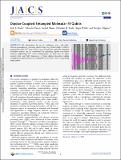Files in this item
Dipolar-coupled entangled molecular 4f qubits
Item metadata
| dc.contributor.author | Bode, Bela E. | |
| dc.contributor.author | Fusco, Edoardo | |
| dc.contributor.author | Nixon, Rachel | |
| dc.contributor.author | Buch, Christian | |
| dc.contributor.author | Weihe, Høgni | |
| dc.contributor.author | Piligkos, Stergios | |
| dc.date.accessioned | 2023-01-26T11:30:17Z | |
| dc.date.available | 2023-01-26T11:30:17Z | |
| dc.date.issued | 2023-02-08 | |
| dc.identifier | 282936259 | |
| dc.identifier | 25e9bc3e-2ade-4dea-b56c-26c130956b5d | |
| dc.identifier | 85147107540 | |
| dc.identifier.citation | Bode , B E , Fusco , E , Nixon , R , Buch , C , Weihe , H & Piligkos , S 2023 , ' Dipolar-coupled entangled molecular 4f qubits ' , Journal of the American Chemical Society , vol. 145 , no. 5 , pp. 2877-2883 . https://doi.org/10.1021/jacs.2c10902 | en |
| dc.identifier.issn | 0002-7863 | |
| dc.identifier.other | ORCID: /0000-0002-3384-271X/work/127573632 | |
| dc.identifier.uri | https://hdl.handle.net/10023/26834 | |
| dc.description | Funding: S.P. thanks the Novo Nordisk Foundation for research grant NNF20OC0065610. EPR Equipment funding by BBSRC to B. E. B. (17 Alert grant BB/R013780/1) is also gratefully acknowledged. | en |
| dc.description.abstract | We demonstrate by use of continuous wave- and pulse-electron paramagnetic resonance spectroscopy on oriented single crystals of magnetically dilute YbIII ions in Yb0.01Lu0.99(trensal) that molecular entangled two-qubit systems can be constructed by exploiting dipolar interactions between neighboring YbIII centers. Furthermore, we show that the phase memory time and Rabi frequencies of these dipolar-interaction-coupled entangled two-qubit systems are comparable to the ones of the corresponding single qubits. | |
| dc.format.extent | 7 | |
| dc.format.extent | 4612021 | |
| dc.language.iso | eng | |
| dc.relation.ispartof | Journal of the American Chemical Society | en |
| dc.subject | QD Chemistry | en |
| dc.subject | DAS | en |
| dc.subject | MCC | en |
| dc.subject.lcc | QD | en |
| dc.title | Dipolar-coupled entangled molecular 4f qubits | en |
| dc.type | Journal article | en |
| dc.contributor.sponsor | BBSRC | en |
| dc.contributor.institution | University of St Andrews. EaSTCHEM | en |
| dc.contributor.institution | University of St Andrews. Biomedical Sciences Research Complex | en |
| dc.contributor.institution | University of St Andrews. Centre of Magnetic Resonance | en |
| dc.contributor.institution | University of St Andrews. School of Chemistry | en |
| dc.identifier.doi | 10.1021/jacs.2c10902 | |
| dc.description.status | Peer reviewed | en |
| dc.identifier.grantnumber | BB/R013780/1 | en |
This item appears in the following Collection(s)
Items in the St Andrews Research Repository are protected by copyright, with all rights reserved, unless otherwise indicated.

